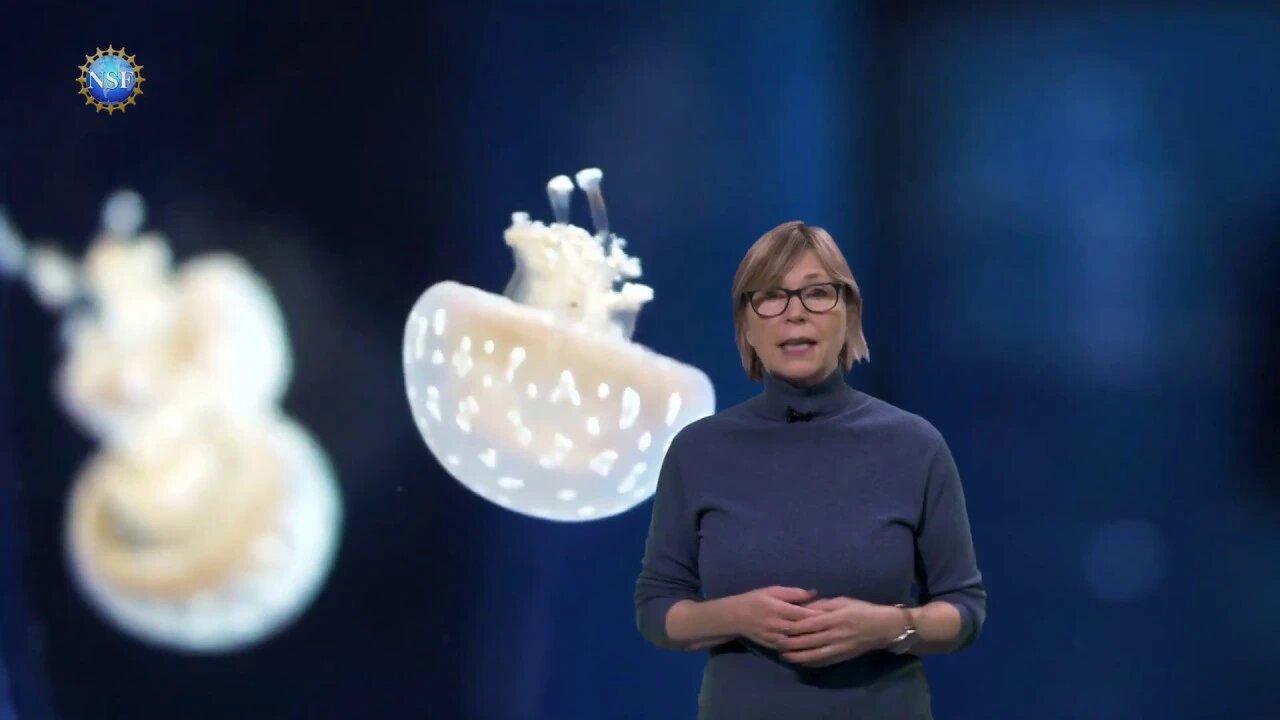Premium Only Content

How does this jellyfish sting without touching you?
In warm coastal waters around the world, swimmers can often spot large groups of jellyfish pulsing rhythmically on the seafloor. Unless properly prepared with protective clothing, it is best to steer clear of areas that Cassiopea, or upside-down jellyfish inhabit: getting too close can lead to irritating stings, even without direct contact.
https://www.eurekalert.org/pub_releas...
Now, researchers, with support in part by the U.S. National Science Foundation, have taken a close look at the cause of the "stinging water" encountered near these placid-looking creatures: a toxin-filled mucus the jellyfish release into the water. In the Feb. 13 issue of the journal Communications Biology, a journal from Nature Research, a team led by scientists at the Smithsonian's National Museum of Natural History, the University of Kansas and the U.S. Naval Research Laboratory reports on microscopic structures they have discovered inside the mucus--gyrating balls of stinging cells that they call cassiosomes.
"This discovery was both a surprise and a long-awaited resolution to the mystery of stinging water," said Cheryl Ames, museum research associate and associate professor at Tohoku University. "We can now let swimmers know that stinging water is caused by upside-down jellyfish, despite their general reputation as a mild stinger." The jellyfish is commonly found in calm, sheltered waters such as lagoons and mangrove forests.
The study, a multidisciplinary exploration of cassiosomes conducted over several years, grew out of the curiosity that Ames, National Oceanic and Atmospheric Administration (NOAA) zoologist Allen Collins and colleagues had about the discomfort they had all experienced firsthand after swimming near upside-down jellyfish. It began when Ames was a graduate student in the invertebrate zoology lab that Collins heads at the museum and culminated when Ames, as a postdoctoral fellow at the U.S. Naval Research Laboratory, investigated the question further as an issue of safety for scientists, the military and recreationists. Initially, Ames said, she and her colleagues were not even sure jellyfish were responsible for their stinging, itching skin, since several other ideas had been put forward about the phenomena, including severed jellyfish tentacles, "sea lice," anemones and other stinging marine animals. But they knew that the upside-jellyfish in the museum's aquarium-room lab tanks released clouds of mucus when they were agitated or feeding, and they wondered if they might find the culprit there.
When Ames and Smithsonian interns Kade Muffett and Mehr Kumar first placed a sample of the jellyfish mucus under a microscope, they were surprised to see bumpy little balls spinning and circulating in the slimy substance. Together with Anna Klompen, a graduate student at the University of Kansas and former museum and NOAA fellow, they turned to several more sophisticated imaging methods to examine the mysterious masses closely, and eventually a clearer picture emerged. The bumpy blobs, they discovered, were actually hollow spheres of cells, probably filled with the same jelly-like substance that gives jellyfish their structure. Most of the outer cells were stinging cells known as nematocytes. Other cells were present, too, including some with cilia--waving, hairlike filaments that propel the cassiosomes' movements. Puzzlingly, inside the jelly-filled center of each sphere was a bit of ochre-colored symbiotic algae--the same sort that lives inside the jellyfish itself.
Taking another look at the jellyfish themselves, the team was able to detect cassiosomes clustered into small spoon-like structures on the creatures' arms. When they gently provoked a jellyfish, they could see cassiosomes slowly break away, steadily leaving the appendages until thousands of them mingled with the animal's mucus. They also found that the cassiosomes were efficient killers of lab-fed brine shrimp, and videos that the team produced show tiny crustaceans succumbing quickly to the venomous spheres in the lab. Molecular analyses conducted at the museum and the U.S. Naval Research Laboratory identified three different toxins within the cassiosomes.
Funding and support for this research were provided by the Smithsonian, the U.S. Naval Research Laboratory, the Defense Advanced Research Projects Agency, the National Oceanic and Atmospheric Administration, the National Science Foundation, the National Aquarium, the National Research Council, the University of Kansas and the American Museum of Natural History.
Subscribe now for more videos from over 200 sources!
https://www.bitchute.com/channel/YsJ0PYUWx5An/
https://www.patreon.com/user?u=26453564
Subscribe to my entertainment channel or at least peek at my other channel !!! https://www.youtube.com/channel/UCiNFsoytAuun90UzU5AuxXg
-
 4:29
4:29
Kurt's News
1 month agoNBC Guest NUKES Jen Psaki For HYPOCRISY On Trump Nominations
87 -
 1:50:39
1:50:39
Kim Iversen
13 hours agoShocking Proposal: Elon Musk for Speaker of the House?! | IDF Soldiers Reveal Atrocities—'Everyone Is a Terrorist'
86.4K204 -
 43:27
43:27
barstoolsports
16 hours agoOld Dog Bites Back | Surviving Barstool S4 Ep. 9
141K4 -
 5:13:04
5:13:04
Right Side Broadcasting Network
7 days agoLIVE REPLAY: TPUSA's America Fest Conference: Day One - 12/19/24
191K28 -
 1:06:01
1:06:01
Man in America
1 day agoPfizer Has Been Caught RED HANDED w/ Dr. Chris Flowers
67.4K54 -
 2:24:15
2:24:15
Slightly Offensive
14 hours ago $19.65 earnedAttempted ASSASSINATION of Nick J Fuentes LEAVES 1 DEAD! | Guest: Mel K & Breanna Morello
56.1K91 -
 1:43:08
1:43:08
Roseanne Barr
14 hours ago $30.10 earned"Ain't Nobody Good" with Jesse Lee Peterson | The Roseanne Barr Podcast #79
88.3K82 -

The StoneZONE with Roger Stone
11 hours agoTrump Should Sue Billionaire Governor JB Pritzker for Calling Him a Rapist | The StoneZONE
55.7K7 -
 1:36:58
1:36:58
Flyover Conservatives
1 day agoAmerica’s Psychiatrist Speaks Out: Are We Greenlighting Violence? - Dr. Carole Lieberman | FOC Show
37.8K6 -
 6:44:54
6:44:54
LittleSaltyBear
12 hours ago $3.44 earnedNecromancing Path of Exile 2 4K
32K4